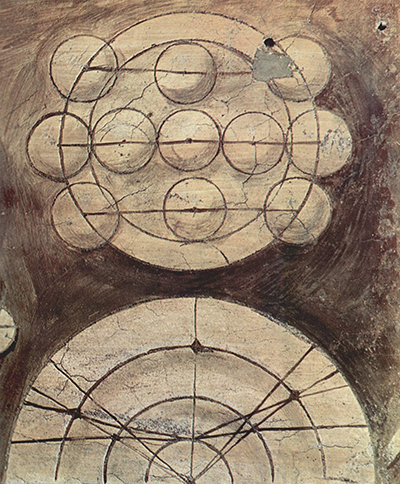Arithmetic is a still life fresco that Giorgio da Castelfranco, or Giorgione, did around 1510. Fresco paintings apply water-based pigments on wet lime plaster. Usually, the artwork is part of a wall. Arithmetic was a different subject for the artist who was fascinated with nature.
Landscapes were Giorgione's favourites, and he receives credit for driving the style to become what it is now. Giorgione's Arithmetic is a combination of different shapes that come together in deliberate patterns. The piece consists of two geometrical circles, one larger than the other with the smaller one set on top. On the outside diameter of the first circle are three almost identical spheres on the opposite arcs. An inner circle provides a second diameter that cuts slightly through the spheres.
The inside circle houses five other domes. Giorgione was meticulous with the measurements of the circles and spheres. The small domes that rise slightly from the wall surface create a perfect balance. Their arrangement puts five spheres in the middle of the ring with a line connecting all of them. Then three domes sit at the top and three at the bottom. The sphere in the middle serves as a perfect centre.
The second section of the fresco has four diameters, so it's several circles in one. However, this part of the piece is not complete. It appears as if the circle is cut in half such that only the top portion is visible. A perpendicular line runs from the outermost radius to the centre of the circle. Several other lines sprout from the core to the outside arc. Even though these lines crisscross each other, they still appear calculated. The artist used a cream pigment for the circles and the wall around it is a dark brown. Cracks on the wall add a different element to the deliberate lines and curves.
The Italian artist lived a short life and a shorter career. Not a lot is known about Giorgione and his artwork. Many of the interpretations regarding his pieces are conjecture and educated guesses from experts. What was clear about the painter is that he sought to challenge what was then the modern style of art. He did Arithmetic in High Renaissance, which is one of the techniques for which he was famous. It's not evident if Giorgione did any other pieces such as Arithmetic. The fresco still life reflects balance and attention to detail. In the first circle, each part connects to the other without missing a beat. A closer look shows that the middle of the first circle aligns perfectly with that of the second one. Even though the two entities have space separating them, they remain connected and might be the whole point of this geometrical setup.




